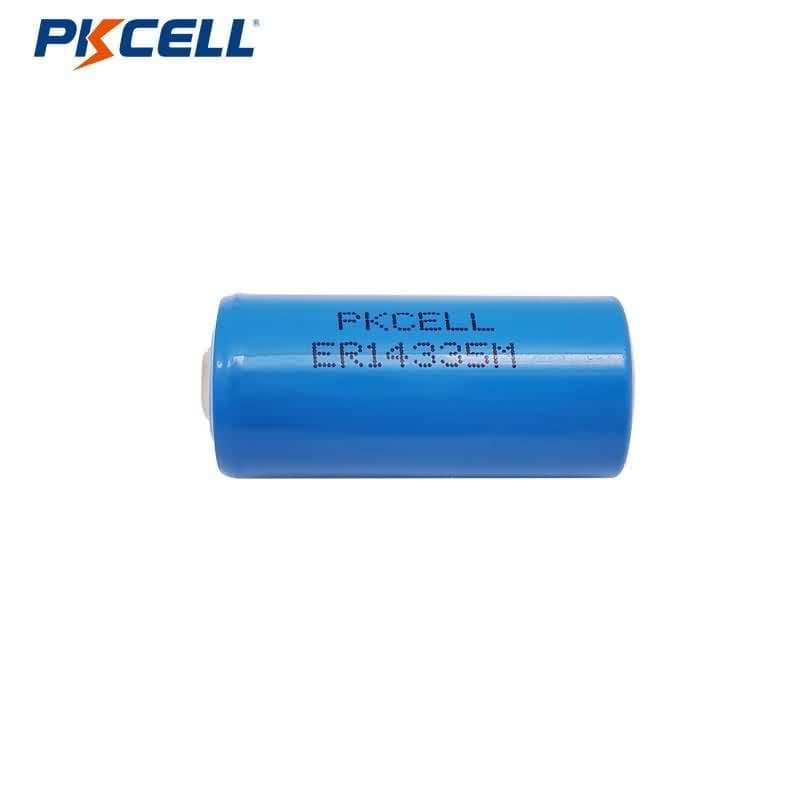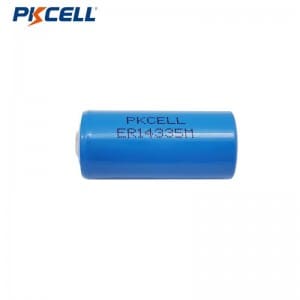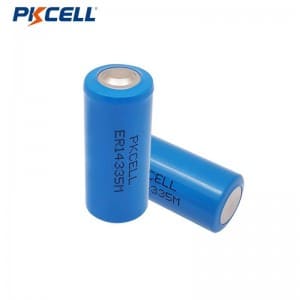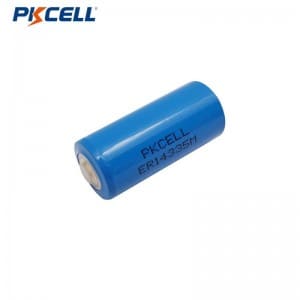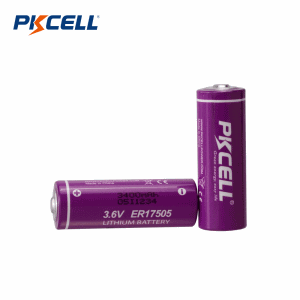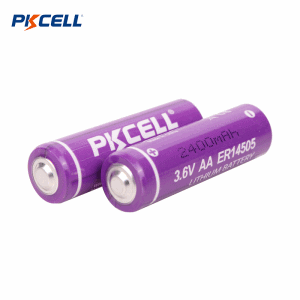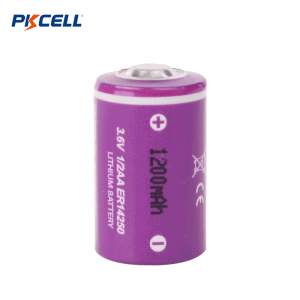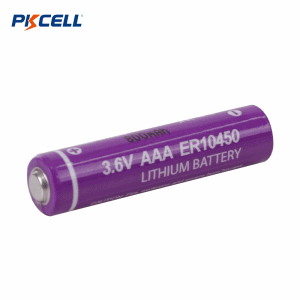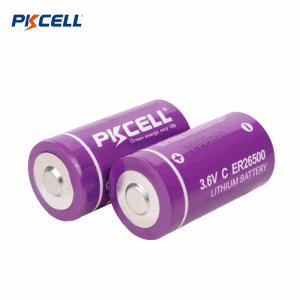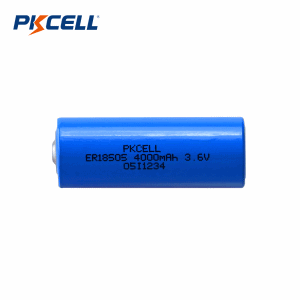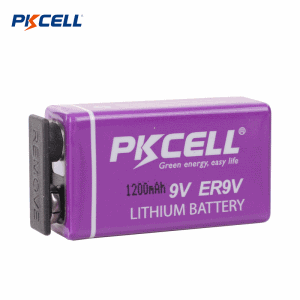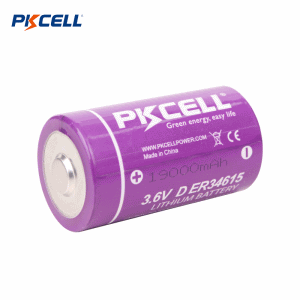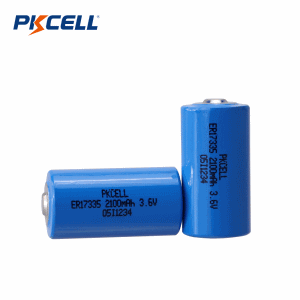3.6V 2/3AA ER14335M Li-SoCl2 Battery 1200 mAh | Pkcell
Understanding ER14335M Battery
The ER14335M battery is a 2/3AA size and is a non-rechargeable lithium battery. This battery uses lithium thionyl chloride (Li-SOCl2) as its chemical makeup. It gives a constant voltage of 3.6 volts. However, the ER14335M has a special internal structure. This makes it better for medium-to-high-current tasks. Its capacity is slightly lower at about 1200mAh. Still, it can manage higher pulse and ongoing currents. The ER14335M lithium 3.6 v battery is perfect for devices needing quick power boosts. It also works well in challenging situations where the temperature changes and vibrations happen.
Key Features of Pkcell ER14335M
- High and Stable Voltage
- High Minimum Voltage During Pulsing
- Stainless Steel Container
- Hermetic Glass-to-metal Sealing
- Low Self-discharge Rate (Less than 1% After 1 year of Storage at +25℃)
- Wide Operating Temperature (-60℃~+85℃)
- Restricted for transport(class 9)
Main Applications of Pkcell ER14335M
- Gas Metering
- Utility Metering
- Alarms and Security Devices
- Memory Back-up
- Tracking Systems
- Professional Electronics
Cost-effective Alternatives to Tadiran, Saft, Xeno & Tekcell
| PKCELL ER Model | Equivalent Competitor Model(s) |
|---|---|
| ER26500 | LS26500 (Saft) |
| ER14505 | LS14500 (Saft), XL-145F (Xeno), Tekcell SB-AA02, TL-5186 (varies) |
| ER14250 | TL-5902 (Tadiran), Tekcell 1/2AA, TL-2150, XL-060F, XL-055F, SL-760, TL-5104, LS14250 |
| ER17505 | LS17500 (Saft) |
| ER34615 | LS33600 (Saft), TL-5930 (Tadiran), TL-5920, XL-205F, LSH20 (Saft) |
| ER18505 | LS-18505, TL-5955 (Tadiran) |
| ER17335 | LS-17335, TL-5903 (Tadiran), TL-5903S |
Specification Of Other Li-SOCl2(Power Type) Models
| Model IEC | Nominal Voltage | Dimensions | Nominal Capacity | Standard Current | Max Continuous Discharge Current | Max Pulse Discharge Current | Cut-off Voltage | Weight Approx | Operating Temperature | |
|---|---|---|---|---|---|---|---|---|---|---|
| ER14250M | 1/2AA | 3.6 | 14.5×25.0 | 1200 | 0.50 | 120 | 250 | 2.00 | 10 | -55~+85 |
| ER14335M | 2/3AA | 3.6 | 14.5×33.5 | 1650 | 0.70 | 300 | 500 | 2.00 | 13 | -55~+85 |
| ER14505M | AA | 3.6 | 14.5×50.5 | 2400 | 1.00 | 500 | 1000 | 2.00 | 19 | -55~+85 |
| ER17335M | 3.6 | 17×33.5 | 2100 | 1.00 | 500 | 1000 | 2.00 | 20 | -55~+85 | |
| ER17505M | 3.6 | 17×50.5 | 3400 | 1.00 | 600 | 200 | 2.00 | 29 | -55~+85 | |
| ER18505M | A | 3.6 | 18.5×50.5 | 4000 | 1.00 | 800 | 1200 | 2.00 | 32 | -55~+85 |
| ER26500M | C | 3.6 | 26.2×50.5 | 8500 | 2.00 | 1000 | 1500 | 2.00 | 55 | -55~+85 |
| ER34615M | D | 3.6 | 34.2×61.5 | 19000 | 3.00 | 2000 | 3000 | 2.00 | 106 | -55~+85 |
More Than Just Individual Cells - We Offer Complete Power Solutions.
- Single Battery With Cables and Connectors
- Custom LiSOCl2 Battery Packs Based on Your Tailored Needs

Why Choose Pkcell Battery?
Typical Discharge Characteristics
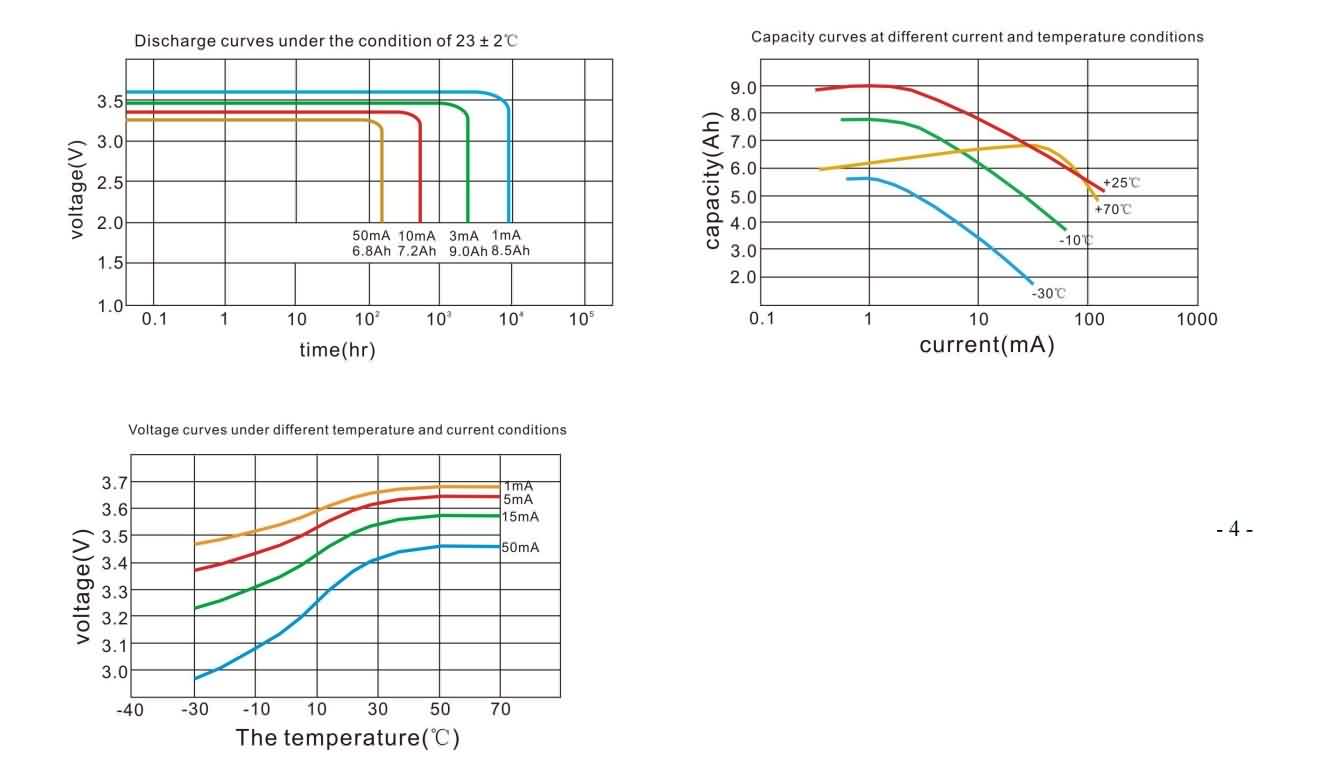
Warning:
- These are non rechargeable batteries.
- Do not recharge, short circuit,crush, disassemble, heat above 100℃ incinerate.
- Do not use the battery beyond the permitted temperature range.
Frequently Asked About LiSoCl2 Battery
- Lead Time: Standard samples typically arrive in 7-12 days. Formal orders usually take around 25 days, though smaller quantities might ship faster, potentially within 15-18 days.
- Payment Methods: We accept various payment types, including T/T (Telegraphic Transfer), L/C (Letter of Credit), and PayPal.
- Shipping: We offer flexibility! Depending on your needs and location, we can ship your order via air freight (using carriers like FEDEX, DHL, UPS, EMS, etc.) or via sea freight.
- Delivery Terms: We can work with several common international shipping terms, including EXW, FCA, FOB, CFR, and DDU.
We have a minimum order value of USD $500. The actual quantity you receive depends on the unit price of the specific batteries you choose. Absolutely! We understand you need to test our products. We're happy to provide samples for your evaluation before you place a formal order.
Passivation is an interesting natural phenomenon observed in Lithium Thionyl Chloride (LiSO₂Cl₂) batteries! When lithium metal touches the thionyl chloride (SOCl₂) electrolyte, a thin, protective layer forms on the surface of the lithium negative electrode. This layer, mostly made up of Lithium Chloride (LiCl), creates a high-resistance barrier that prevents a continuous reaction between the lithium and the electrolyte. Isn't it fascinating how this process helps maintain the battery's performance?
Passivation has some excellent benefits along with a few potential drawbacks that are important to consider:
Benefits:
- Low Self-Discharge: The passivation layer does a fantastic job of slowing down any unwanted side reactions between the lithium and the electrolyte, leading to an impressively low self-discharge rate. Thanks to this, LiSO₂Cl₂ batteries can be stored for many years, often over 10 years, while still keeping most of their capacity intact.
- Long Shelf Life: Because of the low self-discharge, these batteries can hold onto their energy for quite an extended period, which is great for long-term storage.
Potential Drawbacks:
- Voltage Delay: When a passivated battery starts discharging—especially after being stored or during high-current pulses—the current first needs to break through or dissolve the high-resistance passivation layer. This can temporarily drop the battery's voltage below its normal operating level before it bounces back. This occurrence is often referred to as "voltage delay."
Thanks to its combination of high energy density, extended service life, and strong pulse capability, the ER14335M battery is widely utilized across various industrial and professional sectors. Common applications include smart utility metering (particularly gas and water meters with wireless communication), wireless security sensors (e.g., motion detectors, door/window contacts), remote monitoring devices, industrial IoT (Internet of Things) sensors, and memory backup for critical industrial equipment where periodic high-current draws for data transmission or activation are necessary.
Choosing an ER14335M battery provides several notable benefits for demanding applications:
- Superior Pulse Current Capability: Its spirally wound design allows it to deliver robust current pulses, crucial for intermittent operations like radio data transmission or activating components.
- High Energy Density: It packs a substantial amount of energy into its compact 2/3 AA size, contributing to exceptionally long operational lifespans—often many years.
- Extended Shelf Life: With a very low self-discharge rate (typically less than 1% per year), these batteries can be stored for 10-20 years without significant capacity loss, making them ideal for long deployment cycles.
- Stable Voltage Output: It maintains a consistent 3.6V throughout most of its service life, which is critical for the reliable operation of sensitive electronic devices.
- Wide Operating Temperature Range: This battery performs reliably in harsh environmental conditions, commonly from -55°C to +85°C.
No, the ER14335M battery is a primary (non-rechargeable) cell. It's designed for single use only. Attempting to recharge this battery is extremely dangerous and can lead to severe hazards such as leakage, overheating, rupture, fire, or even an explosion. Always replace depleted ER14335M batteries with new ones.
The primary distinction between the ER14335M and a standard bobbin-type Li-SOCl2 cell (like some versions of ER14335 without the 'M' designation) lies in their internal construction and, consequently, their current delivery capabilities. The ER14335M, with its spirally wound construction, is specifically engineered to provide significantly higher pulse currents. In contrast, bobbin cells are optimized for very low, continuous current drains over extended periods. Therefore, while both offer long life, the "M" version is chosen when applications require intermittent, but substantial, power boosts.
While generally safe when used correctly, it's crucial to adhere to these important safety measures:
- Never attempt to recharge these batteries under any circumstances.
- Avoid short-circuiting the battery terminals, as this can cause rapid heat generation and potential hazards.
- Do not puncture, crush, disassemble, or heat the battery above its specified temperature limits or expose it to open flames.
- Store batteries in a cool, dry place, away from direct sunlight, moisture, or extreme heat.
- Ensure proper disposal of used or damaged batteries according to local regulations for lithium batteries, as they contain hazardous materials.
- Keep batteries out of reach of children and pets to prevent accidental ingestion or misuse.


